Climate adaptation

|
| https://data.giss.nasa.gov//gistemp/maps/ |
Contents |
[edit] Introduction
Climate adaptation is a term often used in tandem with climate mitigation to describe the process of adjustment to current and future climates.
In terms of building design, the term resilience is often used to describe how well a building might withstand these changes. This can mean adjusting allowances for average and peak external temperatures, particularly in hotter months, but also considering higher wind speeds and driving rain and should be considered in tandem with potential knock-on effects such as increased cooling loads.
Some example studies from the UK government funded competition Design for Future Climate (D4FC) are useful as reference points, as well as BREEAM Adaptation to climate change and BRE Design for Future Climate - Developing an Adaptation Strategy.
[edit] UK climate projections
Globally the climate is changing. In the UK these changes have been recorded by the Met Office Hadley Centre since the 1990’s. This work has led to projections being issued, such as the UK climate projections in 2009 (UKCP09), which can be considered as a key resource informing regulations and policy-making in the.
Although projections are limited in their robustness they represent one of the best sources of knowledge we have. The Special Report on Emission Scenarios (SRES) that was used in these projections did not consider the potential impact of mitigation measures, and so to incorporate this a set of pathways projections were developed. Ref https://www.metoffice.gov.uk/research/approach/collaboration/ukcp/index
[edit] Representative concentration pathways
Representative Concentration Pathways (RCPs) are used as a method for projecting within a certain set of scenarios used for modelling. The emission scenarios are based on the difference between incoming and outgoing radiation (caused by emissions), these have been set at 2.6, 4.5, 6.0 and 8.5 watts per square metre (Wm-2). The names of the Representative Concentration Pathways reflect these with RCP2.6, RCP4.5, RCP6.0. and RCP8.5. Each pathway results in a different change in global mean temperature; 1.6 (0.9-2.3), 2.4 (1.7-3.2), 2.8 (2.0-3.7), 4.4 (3.2-5.4) degrees C respectively for the years between 2081-2100.
[edit] Related articles on Designing Buildings
- Adaptability.
- Approved Document O.
- Better prediction of overheating in new homes.
- Comfort in low energy buildings.
- Resilience.
- BREEAM Adaptation to climate change.
- BREEAM Designing for durability and resilience.
- Building back better with BREEAM.
- Building Back Better: Resilience
- Building flood resilience.
- Business resilience.
- Climate resilient places.
- Designing resilient cities: a guide to good practice (EP 103).
- Design summer year (DSY)
- Engineering in the 21st century.
- Engineering resilience to human threats.
- Environmental plan for building design and construction.
- Flood resilience.
- Future proofing construction.
- Hurricane design considerations.
- Managing and responding to disaster.
- Overheating in buildings
- Pressing pause to avoid errors.
- Property flood resilience.
- Re-evaluating the design life of buildings.
- Resilient infrastructure diversity and equity scorecard.
- Risk assessment.
- Shelter.
- Sustainability in building design and construction.
- Test reference year (TRY)
- Two steps towards a more resilient world.
Featured articles and news
RTPI leader to become new CIOB Chief Executive Officer
Dr Victoria Hills MRTPI, FICE to take over after Caroline Gumble’s departure.
Social and affordable housing, a long term plan for delivery
The “Delivering a Decade of Renewal for Social and Affordable Housing” strategy sets out future path.
A change to adoptive architecture
Effects of global weather warming on architectural detailing, material choice and human interaction.
The proposed publicly owned and backed subsidiary of Homes England, to facilitate new homes.
How big is the problem and what can we do to mitigate the effects?
Overheating guidance and tools for building designers
A number of cool guides to help with the heat.
The UK's Modern Industrial Strategy: A 10 year plan
Previous consultation criticism, current key elements and general support with some persisting reservations.
Building Safety Regulator reforms
New roles, new staff and a new fast track service pave the way for a single construction regulator.
Architectural Technologist CPDs and Communications
CIAT CPD… and how you can do it!
Cooling centres and cool spaces
Managing extreme heat in cities by directing the public to places for heat stress relief and water sources.
Winter gardens: A brief history and warm variations
Extending the season with glass in different forms and terms.
Restoring Great Yarmouth's Winter Gardens
Transforming one of the least sustainable constructions imaginable.
Construction Skills Mission Board launch sector drive
Newly formed government and industry collaboration set strategy for recruiting an additional 100,000 construction workers a year.
New Architects Code comes into effect in September 2025
ARB Architects Code of Conduct and Practice available with ongoing consultation regarding guidance.
Welsh Skills Body (Medr) launches ambitious plan
The new skills body brings together funding and regulation of tertiary education and research for the devolved nation.
Paul Gandy FCIOB announced as next CIOB President
Former Tilbury Douglas CEO takes helm.
UK Infrastructure: A 10 Year Strategy. In brief with reactions
With the National Infrastructure and Service Transformation Authority (NISTA).






















